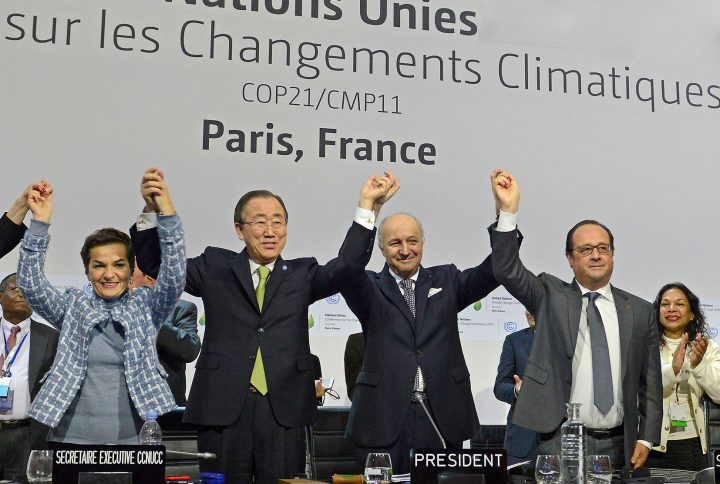On August 4, 2017, the United States officially notified the Secretary-General of the United Nations of its intention to withdraw from the Paris Agreement on Climate Change signed in December 2015. The Secretary-General of the United Nations is the depositary of this multilateral agreement, signed by 195 States, and ratified by 159 States: see official status of signatures and ratification (at the very end, the declarations made by 18 Parties are available).
One of the last withdrawals from an environmental UN treaty took place in 2013 when Canada decided to withdraw from the UN Convention to Combat Desertification: it can be read in the official status of signatures and ratification of this treaty that
“Canada had signed the Convention on 14 October 1994 and had ratified it subsequently on 1 December 1995. Thereafter, on 28 March 2013, in accordance with its article 38 (2), the Government of Canada had notified the Secretary-General of its decision to withdraw from the Convention. The withdrawal took effect on 28 March 2014. On 21 December 2016, Canada deposited with the Secretary-General an instrument of accession to the Convention” (Note 4).
Legally speaking, and in accordance with the text of the Paris Agreement of 2015, no formal notification to the UN on its decision to withdraw can be done by a State before November 2019. Additionally, no withdrawal will take effect until November 2020. On this respect, the rules of Article 28 concerning withdrawal are extremely clear:
Article 28 1. At any time after three years from the date on which this Agreement has entered into force for a Party, that Party may withdraw from this Agreement by giving written notification to the Depositary.
2. Any such withdrawal shall take effect upon expiry of one year from the date of receipt by the Depositary of the notification of withdrawal, or on such later date as may be specified in the notification of withdrawal.
3. Any Party that withdraws from the Convention shall be considered as also having withdrawn from this Agreement.
If the idea is to say that the United States wants to withdraw from this multilateral agreement, official declarations made by President Trump a few months ago are sufficient. The entire world, as well as the United Nations, understood the very peculiar vision of President Trump when affirming last May that the Paris Agreement decision will “make America great again“.
We refer to the article published in an EJIL-Talk on June 5, 2017 by Professor Lavanya Rajamani (India), entitled “Reflections on the US withdrawal from the Paris Climate Change Agreement“.
We have had the opportunity to analyse the official reactions in Latin America to this annoucement of President Trump (see our note published in DebateGlobal on June 4, 2017 and entitled: “Reacciones en América Latina a anuncio de retiro de Estados Unidos del Acuerdo de París sobre Cambio Climático“). In the conclusion, it can be read that:
“Beyond his very peculiar way of announcing things (and then reflecting on the impact they may cause) that President Donald Trump has exhibited since his arrival in the White House, from the strictly legal point of view, the express prohibition of making reservations to this treaty as such (see article 27 of the Paris Agreement) leads to the impossibility of limiting or modulating the scope of some of its dispositions. Technically, the USA will have to in this case start by denouncing the treaty, or rather to proceed with an unusual request that both the depositary of the Paris Agreements and its States Parties wait (anxiously), along with all the specialists in international law.”
The text of the letter signed by Ambassador Nikki Haley, dated August 4, 2017, reproduced in this article, reads as follows:
“The Representative of the Unites States of America to the United Nations presents her compliments to the Secretary-General of the United Nations.
This is to inform the Secretary-General, in connection with the Paris Agreement, adopted at Paris on December 12, 2015 (“the Agreement”), that the United States intends to exercise its right to withdraw from the Agreement. Unless the United States identifies suitable terms for reengagement, the United States will submit to the Secretary-General, in accordance with Article 28, paragraph 1 of the Agreement, formal written notification of its withdrawal as soon as it is eligible to do so. Pending the submission of that notification, in the interest of transparency for parties to the Agreement, the United States requests that the Secretary-General inform the parties to the Agreement and the States entitled to become parties to the Agreement of this communication relating to the Agreement.
The Representative of the Unites States of America to the United Nations avails herself of the opportunity to renew to the Secretary-General the assurances of her highest consideration“.
It seems to be a very first time that a State notifies its intention instead of its decision to withdraw from a treaty. On the other hand, it must be noted that to notify its intention to withdraw from a treaty and to announce at the same time that the United States will “reengage”, is also something very new in international law: mainly when it is a treaty containing a clause on the prohibition of reservations (Article 27).










